|
|
|
Sort Order |
|
|
|
Items / Page
|
|
|
|
|
|
|
| Srl | Item |
| 1 |
ID:
162945
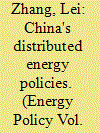

|
|
|
|
|
| Summary/Abstract |
Distributed energy (DE) is a way to cascade energy use near multiple users. It significantly impacts energy savings, emission reductions and energy structure upgrades. In recent years, all levels of the Chinese government have strived to introduce policies favorable to the implementation of DE. These policies have been affected by the timing of the introduction, regional economic differences, the degree of government attention, and many other complex factors. To clarify the development and links between these policies, this study summarizes and compares China's DE policies at national, provincial, and municipal levels, from 1989 to 2016. We analyze the scope and content of subsidies in detail, and then provide policy recommendations for DE development in China. The main results are as follows: (1) DE policies emerge from legal provisions in the areas of energy, electricity, and environmental protection. The policies have gradually evolved from macro-plans to specific guidance. (2) The demand for DE subsidies is increasing, making the back slope of subsidies significant under an insufficient government budget. Diverse subsidies are needed to address this contradiction. (3) Future policies should focus on comprehensive DE utilization, smart grids, research and development (R&D), and developing policy synergies at different levels.
|
|
|
|
|
|
|
|
|
|
|
|
|
|
|
|
| 2 |
ID:
112716


|
|
|
|
|
| Publication |
2012.
|
| Summary/Abstract |
This paper estimates peer effects on student achievement using a panel data set from a middle school in China. Unique features of the organization of Chinese middle schools (Grades 7 to 9) and panel data allow us to overcome difficulties that have hindered the separation of peer effects from omitted individual factors due to self-selection and from common teacher effects and to identify peer effects at the classroom level. We estimate peer effects for Math, English, and Chinese test scores separately. In a linear-in-means model controlling for both individual and teacher-by-test fixed effects, peers are found to have a positive and significant effect on math test scores, a positive but insignificant effect on Chinese test scores, but no effect on English test scores. Importantly, in Math and Chinese students at the middle of the ability distribution tend to benefit from better peers, whereas students at the ends of the ability distribution do not, suggesting that policy makers who want to exploit positive peer effects face difficult tradeoffs in classroom and school assignment.
|
|
|
|
|
|
|
|
|
|
|
|
|
|
|
|
| 3 |
ID:
126476


|
|
|
|
|
| Publication |
2013.
|
| Summary/Abstract |
Under the dual pressures of an energy crisis and rising greenhouse gas emissions, biomass energy development and utilisation has become part of the national energy strategy in China. The last decade has witnessed a strong promotion of both centralised and decentralised bio-energy systems in rural China. The government seems to have a strong preference for centralised (village-based) bio-energy systems in recent years. However, these government-driven systems have not worked without difficulties, particularly regarding economic and technological viability and maintenance. Studies on the advantages and disadvantages of decentralised and centralised bio-energy systems are rare. This study aims to shed light on the performances of these two systems in terms of social, economic and environmental effects. Through interviewing local officials and village leaders and surveying farmers in 12 villages in Shandong Province, it was found that bio-energy systems should be selected based on the local circumstances. The diversity of the local natural, economic and social situations determines the size, place, technology and organisational model of the bio-energy system.
|
|
|
|
|
|
|
|
|
|
|
|
|
|
|
|
| 4 |
ID:
187805
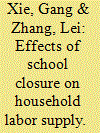

|
|
|
|
|
| Summary/Abstract |
This paper studies the effects of school closure on household labor supply exploiting China's large-scale rural primary school closing during the early 2000s. Using CHNS 1991–2011 and CHIP 2007–2008 datasets and a difference-in-differences approach, we find that school closure significantly increases the total annual income of mothers of primary school-aged children, which comes virtually entirely from increases in wage income, due to more participation, more working hours, and higher wage rates. This significant positive effect can plausibly be attributed to their migration responses: mothers engage in temporary rural-urban migration to care for children following school closure. We find no effects on fathers' income and migration behavior. Our study provides the first causal estimation of the impacts of school closure on household labor supply and sheds light on the migration decision-making of rural females.
|
|
|
|
|
|
|
|
|
|
|
|
|
|
|
|
| 5 |
ID:
134874
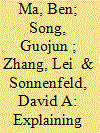

|
|
|
|
|
| Summary/Abstract |
This paper examines sectoral contributions to discrepancies between China's national aggregate statistical values and the sum of provincial figures. In institutional terms, the paper then explores the sources of principally sectoral discrepancies. We find that the industrial sector has been the major contributor to discrepancies in both gross domestic product (GDP) and total energy consumption in recent years. Technical aspects such as statistical coverage, data collection method, and double-counting cannot explain the discrepancy. For the industrial sector, limited data accessibility undermines external checks and balances from the general public. As the primary bodies in collecting industrial data, the Provincial Bureaus of Statistics (PBSs) are not subject to effective internal checks and balances from other governmental divisions. To out-compete counterparts and get promoted, provincial leaders have explicit incentives to overstate provincial GDP, with industrial added value being the first statistic to be affected. This dynamic further extends to industrial energy consumption, which is over-reported as well
|
|
|
|
|
|
|
|
|
|
|
|
|
|
|
|
| 6 |
ID:
110498


|
|
|
|
|
| Publication |
2011.
|
| Summary/Abstract |
Trust and property rights are generally considered to influence farmers' behavior regarding resource use and environmental management. Previous studies show that higher trust levels may enhance contributions to public goods. This paper investigates how trust and (land) property rights security influence the provision of one concrete public good: land protection through the Sloping Land Conservation Program in China. The analysis is based on household survey data from Ningxia Autonomous Region in China. From our questionnaire two trust factors are derived and distinguished, using factor analysis: general trust and kinship trust. Farm households are less likely to contribute to public goods when they perceive more secure land rights, but trust has mixed effects on public goods. The results show that general trust and kinship trust may rely on two opposite effects for influencing public goods provision. On the one hand, high levels of general trust may directly enhance people's willingness to provide contributions to public goods (by reduced likelihood to reconvert forest land) when farmers are aware of the positive environmental effects of the program, that's the public goods effect. On the other hand, general trust may also make it more likely that people invest more in their own private goods to pursue their own welfare (a more likely reconversion of forest land to arable land), that's the private goods effect. The final outcome depends on the size and direction of both effects. Compared to general trust, kinship trust is more inward-looking and self- or group-interested compared to more reciprocal general trust. Thus, unlike general trust, kinship trust may have no significant public goods effect on the provisioning of public goods.
|
|
|
|
|
|
|
|
|
|
|
|
|
|
|
|
| 7 |
ID:
108601
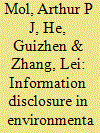

|
|
|
| 8 |
ID:
095833


|
|
|
|
|
| Publication |
2010.
|
| Summary/Abstract |
Human society faces a growing number of risks, including both natural disasters and risks that stem from human behavior. This is particularly true in China, which is experiencing rapid social, economic and political transitions. Since the 1970s, China's modernization process has been accompanied by the emergence of an increasing number of man-made risks, in particular environmental pollution, but until very recently, a risk management system did not exist in China. Society was woken up by a series of disasters and accidents, including SARS in 2003, followed by the explosion of avian flu and the chemical spill in the Songhua River in 2005. The last incident in particular finally kicked off the development of a national risk management system (specifically an emergency response system) in China. This paper analyses the status quo of the legislation, institutions and mechanisms for risk management in China and identifies opportunities and strategies for prioritizing and integrating environmental and health risks into the emerging system. The study concludes that although a series of alarming incidents have succeeded in putting risk management issues at the top of the public and political agenda, currently risk management in China can be characterized as reactive and compartmentalized, with a lack of prioritization and integration of policy efforts and resources. There is also a danger that the traditional state-centered approach may fail to create an effective risk management system, which requires improved transparency, accountability, and cross-sectoral coordination. The paper concludes with the proposal of strategies that might enable the environmental authorities to be more effective and reduce their marginalization and isolation.
|
|
|
|
|
|
|
|
|
|
|
|
|
|
|
|
| 9 |
ID:
176669
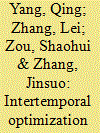

|
|
|
|
|
| Summary/Abstract |
As coal is the main energy source in China, coal overcapacity and undercapacity have negative impacts on the economy, environment, and energy security. To reveal the optimal production capacity (OPC), an intertemporal optimization model under uncertainty is established by a combined Dynamic Programming - Influence Factor - Scenario Analysis - Monte Carlo method (DP–IF–SA-MC). The OPCs in 1990–2025 are solved to minimize the expected cost to the economy and environment driven by the production capacity (PC) under energy security. In addition, we define, and calculate the PC deviation (PCD), or the deviation of the actual PC (APC) from the OPC. The results show that compared with the APC, the OPC has advantages of more stable development, more timely adjustment, and lower cost, and it provides cost savings of 302.857 billion yuan in 1990–2017. According to PCD, China's coal industry existed under the risk of overcapacity in 1990–1999 and 2009–2017 and undercapacity in 2000–2008, and it can experience overcapacity for most of the time without capacity reduction policies. In future, the optimal management of the PC should be based on the OPC and PCD over the next 5–10 years rather than the current capacity utilization rate, and focus on overcapacity management in the long run.
|
|
|
|
|
|
|
|
|
|
|
|
|
|
|
|
| 10 |
ID:
143401
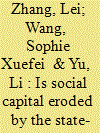

|
|
|
|
|
| Summary/Abstract |
In the rapid urbanization process, indigenous villagers' social capital might be affected by the flooding-in of rural migrants and more importantly by the government's urbanization policies. Based on survey data collected from fifteen Beijing villages in 2011 and 2012, we study the relationship between social capital and urbanization for indigenous villagers in the urban fringe of Beijing. We find that the bottom-up urbanization measured by migrant-local ratio weakened social networks and social trust. However, the top-down urbanization measured by designating policy zone promoted social networks and social trust.
|
|
|
|
|
|
|
|
|
|
|
|
|
|
|
|
| 11 |
ID:
116968


|
|
|
|
|
| Publication |
2012.
|
| Summary/Abstract |
The objective of this study is to identify market segments and estimate the residents' willingness to pay (WTP) for green electricity (green-e) in China for the large-scale promotion of energy projects from renewable sources that do not rely solely on energy policies. Based on an analysis of non-use values of green-e as well as the application of the contingent valuation (CV) method and payment card (PC) introduction technology, the average WTP ranges from RMB 7.91 yuan/month to 10.30 yuan/month (approximately US$ 1.15-1.51/month with an exchange rate of 6.83 yuan/US$ yuan/US$) for urban residents in Jiangsu Province. The current work also explores the differences in demographic variables across varying WTP amounts and the different marginal effects of demographic variables at the same level of WTP. The findings reveal that there are significant differences in demographic variables, such as level of education, household income and location of residence, across the population segments. Moreover, the finding that some respondents with high income and higher education prefer higher WTP amounts to lower WTP amounts suggests that green-e is a luxury product, and consequently, a Veblen effect exists in certain Chinese market segments.
|
|
|
|
|
|
|
|
|
|
|
|
|
|
|
|
|
|
|
|
|